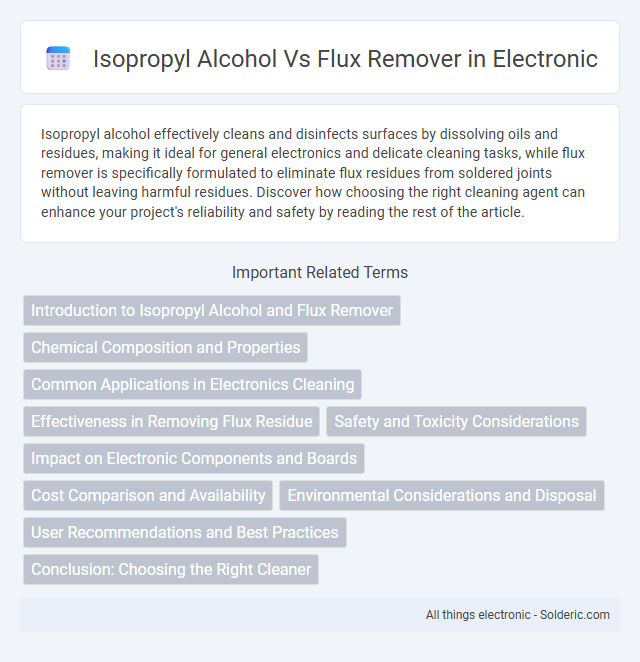Isopropyl alcohol effectively cleans and disinfects surfaces by dissolving oils and residues, making it ideal for general electronics and delicate cleaning tasks, while flux remover is specifically formulated to eliminate flux residues from soldered joints without leaving harmful residues. Discover how choosing the right cleaning agent can enhance your project's reliability and safety by reading the rest of the article.
Comparison Table
| Feature | Isopropyl Alcohol | Flux Remover |
|---|---|---|
| Primary Use | Cleaning electronic components & general disinfectant | Removing solder flux residues from circuit boards |
| Chemical Composition | Isopropanol (C3H8O), usually 70%-99% concentration | Specialized solvent blends (often hydrocarbon or citrus-based) |
| Evaporation Rate | Fast evaporation | Varies, generally slower than isopropyl alcohol |
| Effectiveness | Good for light residue and cleaning | Highly effective on flux residues and stubborn contaminants |
| Safety | Flammable; use in well-ventilated areas | Can be flammable; check MSDS for specific product safety |
| Cost | Economical and widely available | Generally more expensive due to specialized formulation |
| Compatibility | Safe on most plastics and metals used in electronics | May affect sensitive plastics; test before use |
Introduction to Isopropyl Alcohol and Flux Remover
Isopropyl alcohol, a widely used solvent with strong degreasing properties, is commonly employed for cleaning electronic components and removing flux residues due to its quick evaporation and low toxicity. Flux remover, specifically formulated with powerful chemicals, targets stubborn flux residues left after soldering, offering enhanced cleaning efficiency especially in industrial and electronics repair applications. Both substances play crucial roles in maintaining circuit board integrity, but their chemical compositions and cleaning strengths cater to different levels of residue removal.
Chemical Composition and Properties
Isopropyl alcohol is a clear, colorless solvent composed primarily of C3H8O, known for its high volatility, excellent degreasing properties, and ability to evaporate quickly without leaving residue. Flux removers, meanwhile, contain a combination of organic solvents, surfactants, and sometimes corrosion inhibitors designed specifically to break down and dissolve flux residues from soldering processes. Choosing between isopropyl alcohol and flux remover depends on your need for a general-purpose cleaning agent versus a specialized chemical blend tailored to effectively remove flux while protecting electronic components.
Common Applications in Electronics Cleaning
Isopropyl alcohol is widely used in electronics cleaning for removing flux residues, dirt, and oils due to its quick evaporation and non-conductive properties. Flux remover, often formulated with specialized solvents, targets tougher flux residues and corrosion prevention, making it ideal for thorough PCB maintenance and repair. Your choice depends on the cleaning intensity required and sensitivity of electronic components being serviced.
Effectiveness in Removing Flux Residue
Isopropyl alcohol effectively dissolves and cleans flux residue due to its strong solvent properties and rapid evaporation rate, making it ideal for delicate electronics. Flux removers, often formulated with specialized chemicals, provide enhanced effectiveness on stubborn or baked-on flux residues by breaking down flux compounds more thoroughly. Choosing between the two depends on the flux type and residue severity, with flux removers offering superior performance for heavy-duty cleaning.
Safety and Toxicity Considerations
Isopropyl alcohol is generally safer for cleaning electronics due to its lower toxicity and rapid evaporation, reducing prolonged exposure risks. Flux remover often contains stronger chemicals that can be more toxic and require proper ventilation and protective gear to avoid inhalation and skin contact hazards. You should always check the product's safety data sheet and follow recommended handling procedures to minimize health risks during use.
Impact on Electronic Components and Boards
Isopropyl alcohol effectively cleans electronic components and circuit boards by dissolving oils and residues without corroding metal contacts or damaging sensitive parts. Flux removers are specifically formulated to remove solder flux residues, ensuring thorough cleaning while minimizing the risk of leaving conductive or corrosive residues that could impact your board's performance. Choosing the right cleaning agent is crucial to maintaining component integrity and preventing potential short circuits or corrosion.
Cost Comparison and Availability
Isopropyl alcohol is generally more affordable and widely available in pharmacies, supermarkets, and online retailers compared to flux remover, which is often sold by specialized electronics suppliers at a higher price point. Flux remover formulations vary, influencing cost, but isopropyl alcohol's mass production ensures a lower price per volume. Both substances have global availability, but flux remover may require ordering from niche stores or professional distributors, impacting accessibility.
Environmental Considerations and Disposal
Isopropyl alcohol evaporates quickly and is less toxic to the environment, making it easier to dispose of safely compared to many chemical flux removers, which often contain harsh solvents that require specialized waste handling. Flux removers may contain volatile organic compounds (VOCs) that contribute to air pollution and require compliance with hazardous waste regulations during disposal. Your choice should prioritize products with minimal environmental impact and guidelines for proper disposal to protect water sources and soil quality.
User Recommendations and Best Practices
When choosing between isopropyl alcohol and flux remover for cleaning electronic components, it is important to consider the specific residue and sensitivity of your device. Isopropyl alcohol is recommended for light flux residues due to its non-corrosive and fast-evaporating properties, ensuring quick cleanup without damaging delicate circuitry. For heavy or baked-on flux, specialized flux removers provide more effective dissolution but require careful application to avoid component damage; always test on a small area and use proper ventilation to protect your health during the cleaning process.
Conclusion: Choosing the Right Cleaner
Isopropyl alcohol offers effective cleaning for light residues and electronics due to its quick evaporation and non-corrosive properties, while flux remover is specifically formulated to dissolve and eliminate stubborn solder flux. Selecting the right cleaner depends on the nature of contamination and material sensitivity; isopropyl alcohol suits routine maintenance, whereas flux remover ensures thorough flux removal in PCB rework. Understanding these differences guarantees optimal cleaning performance and component safety.
isopropyl alcohol vs flux remover Infographic

 solderic.com
solderic.com